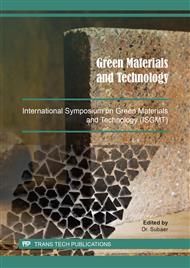p.118
p.123
p.132
p.145
p.150
p.155
p.161
p.171
p.179
The Use of Super Base CaO from Eggshells as a Catalyst in the Process of Biodiesel Production
Abstract:
The use of heterogeneous catalysts in the biodiesel production process provides advantages because it is easier in the catalyst separation process. One type of heterogeneous catalyst that can be used is CaO. The raw materials for CaO are abundant in nature and can be obtained from various sources including agricultural waste such as eggshells. The alkalinity level of CaO can be increased to super baser CaO through the activation process of CaO by using an ammonium carbonate solution. Super base CaO which is used as a catalyst for transesterification reaction in the production of biodiesel made from palm oil. This research was carried out by varying the reaction time starting from 1, 2 and 3 hours. The highest yield was obtained at 3 hours reaction time of 93.92%. The results of the analysis of the physical properties of biodiesel obtained density in the range 853-854 kg/m3, kinematic viscosity 3.24-3.26 mm2/s (cSt), saponification number 193-201 mg-KOH/g biodiesel and acid number 0.3-0.7 mg-KOH/g. These characteristics meet the biodiesel quality standards based on Indonesian National Standard (SNI) 04-7182-2015. Thus the use of super base CaO from eggshells can be used as a catalyst in the process of biodiesel production.
Info:
Periodical:
Pages:
150-154
Citation:
Online since:
August 2019
Authors:
Keywords:
Price:
Сopyright:
© 2019 Trans Tech Publications Ltd. All Rights Reserved
Share:
Citation:



